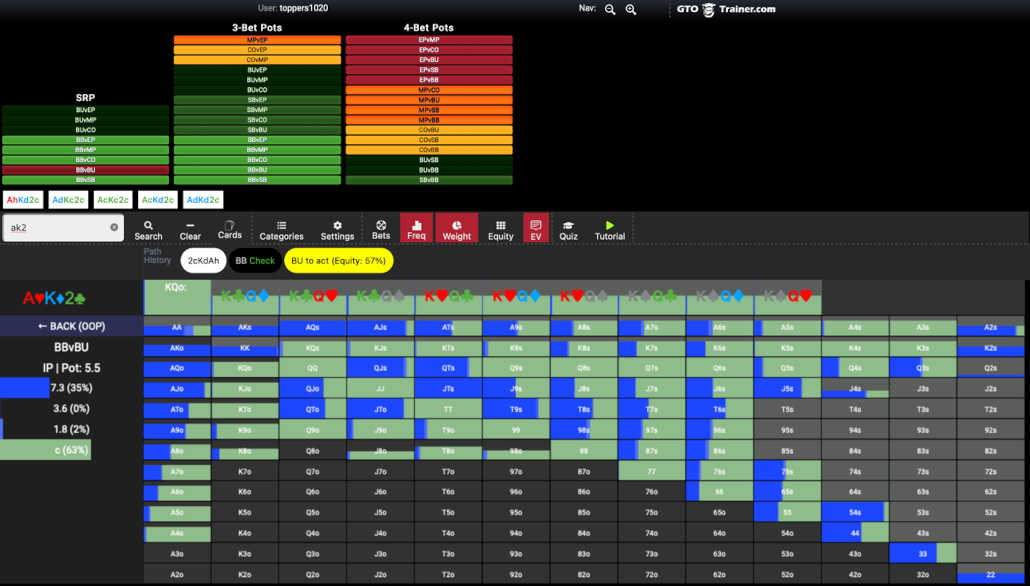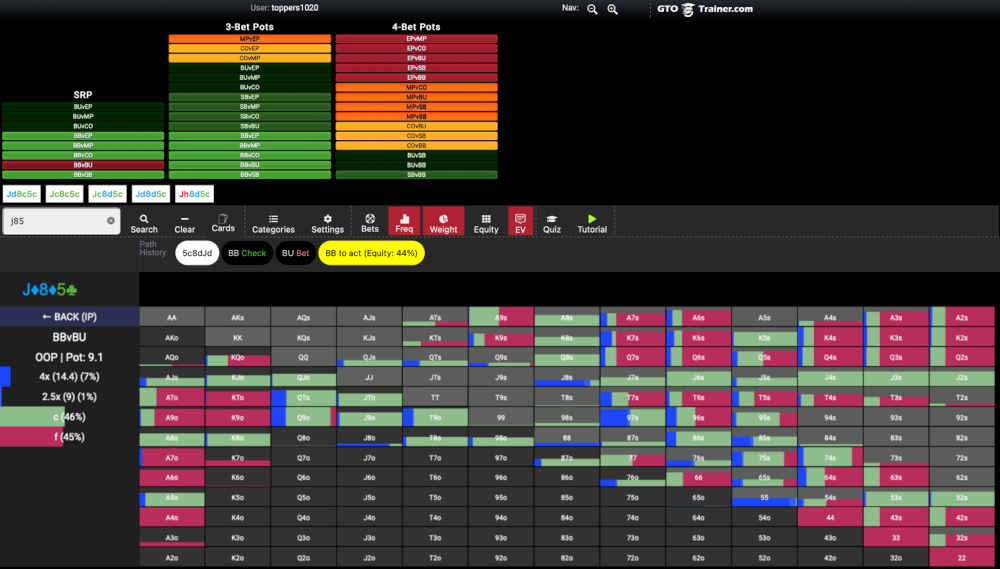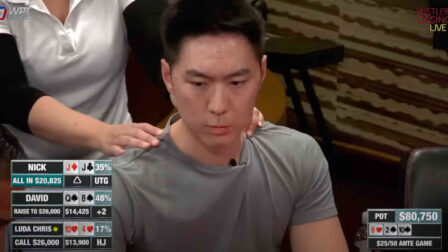How to Effectively Use Random Number Generators in Online Poker

8 minutes
Last Updated: November 10, 2021
If you want to become a better poker player, the higher you progress through the stakes, the more heavily you will need to implement a GTO strategy.
One thing that all poker solvers will suggest is to randomize several aspects of your game. You will find solvers rarely want you to make an action 100% of the time. They would rather it be anywhere from 5% to 95% of the time.
Random Number Generators (RNG) take the human bias out of your decisions.
Humans are terrible at making random decisions, which in poker can often lead you to lean more towards aggressive or passive decisions in the long run.
In other words, without RNG, you are more likely to become unbalanced. In the long run, information can be used to derive an exploitative strategy against you or will cause you to leak some EV from your game.
I’ll be explaining why solvers like to split the decisions, why we need to use random number generators in poker, and I’ll provide some tips detailing how you could implement one into your game, if at all.
Why Do We Need RNG?
RNG is used for two reasons: Balance and Board Coverage. The balance in RNG comes by ensuring that we don’t bet too frequently or infrequently in a situation.
Board coverage helps us stay balanced by keeping our poker hand range stronger on a variety of board textures regardless of the turn or river card.
Balance
We use RNG to keep balanced with our value combinations and bluffs regardless of the action we take in a hand.
We will have two decisions post flop if we want to continue in a hand. These decisions are often called lines.
You have aggressive lines like betting or raising, then passive lines: checking or calling. The use of RNG in a GTO strategy will allow us to reach flops, turns, and rivers with strong hands, irrespective of if we take a passive or aggressive line.
The ability to show up with strong hands regardless of how we play the hand makes us harder to play against and maximizes our EV overall. It also makes our range harder to read and can cause our opponents to make bigger, more costly mistakes.
For example, if you take the aggressive line with every good draw and top pair or better, that betting range will be very strong and filled with good hands.
However, you will be sacrificing profitability when you take the passive line. This is because when you always take aggressive action with your strong hands, you will have no combinations of strong hands left in your range should you call or check.
We use RNG in this situation to sometimes call with our strongest hands instead of raising them.
We will also sometimes check with some good draws to ensure that we can still have the nuts in our passive lines should those draws be completed, for example, the nut flush draw.
RNG also helps us stay balanced by preventing us from making an action too frequently. For example:

You can see on the board above that we have so many potential bluffing combinations on this board texture.
To ensure that we do not bluff with everything and risk being unbalanced by bluffing too frequently, we use RNG to split the strategy. This also gives us greater board coverage moving forward in the hand.
Board Coverage
The use of RNG in a GTO strategy can allow us to reach flops, turns, and rivers with a wider variety of hands.
When you randomize the combinations that you bet on the flop, you increase the ability to have strong hands whatever the turn or river card may be.
This is called increasing the board coverage. Increasing board coverage is ideal for a winning strategy as it prevents your opponent from exploiting you.
One way we can use RNG is to vary the frequency we bet in what is known as a mixed strategy.
For example, when we have top pair, if we only bet with our good top pairs, say with a kicker of T or above, we will remove many two pair combinations we could have on the turn.
If the turn is a card under a T, good opponents understand we can't have turned two pair very frequently. This makes the smaller cards much better for your opponent.
Using RNG to increase our board coverage prevents our opponent from making easy calls or exploitative raises by slightly reducing how strong the next card will be for our opponent. You can look at this in a solver:

As you can see, the solver suggests to overbet, not just with the strongest Ax combinations but also some Ax hands with weaker kickers.
This is so that we maintain the ability to have strong hands on a variety of turns whether we check or bet.
You can also see how it decides to bet with the gutshot straight draws that we have in this situation, very rarely choosing to bet with a combination at 100% frequency.
We also want to use RNG to increase our board coverage by balancing and randomizing our preflop range. You can see some problems in my own simplified microstakes range charts:

If the hand is highlighted and not in green in my range charts here, the hero is to 3-bet with the hand (the different highlight colors dictate what to do after this).This is a section of a range chart that I give to my students, which is appropriate for the smaller stakes online. One thing that it doesn’t contain is any RNG preflop.
This raising strategy leaves us vulnerable on some board textures, especially at higher stakes where players will use data against you.
There are several flops that could come, which limit us to only a few combinations of strong hands. This will leave us vulnerable to being bluffed away from the hand or limit how much value we can extract with our entire range.
Take a second to think about the flops that would be terrible for our 3betting range here. (Hint: notice how we have no 2x containing combinations)
A true GTO preflop strategy will therefore have us 3-betting and calling at some frequency with all the suited broadway combinations, Ax combinations, and some of our smaller pocket pairs.
This gives us the ability to cover a large variety of board textures, which will make our range more dynamic and therefore stronger on whatever the flop may be.
Do You Need to Use RNG?
I frequently see many players using RNG in their game without understanding the need for it. This often means they are making random decisions incorrectly, which is severely detrimental to their win rate.
For example, bluffing with combinations that they shouldn’t be bluffing with at all and justifying the decision with the use of RNG.
I also see players slow-play way too frequently with all their combinations as they are not using the correct frequencies in their decisions. Keeping our passive lines balanced with our strongest hands has a very small frequency attached.
You do not need to use RNG to be a profitable poker player. As you improve in your game, you will start studying GTO strategies in more detail.
If you do not know what the optimal frequencies are with each combination in your range, then you are better off keeping things simple.
A simple winning strategy that is lower in EV than a more complicated one is infinitely better than the complicated strategy implemented incorrectly.
How to Use RNG
To use RNG online, the easiest way is to bring up a number generator from 1-100 on Google. You can click a button and generate a number that you should treat as a percentage.
Let’s say you want to bet 50% of the time and check 50% of the time: You would assign numbers 1 to 50 to “bet” and 51 to 100 to “check.”
Alternatively, you can use an app to do the same thing. Look for an advert-free one, as waiting for an Ad to play before your number comes up will be infuriating.
You should be using RNG as part of a GTO strategy. This is a strategy that you should have studied in detail and must understand what the frequencies should be and when to start using them.
If you are looking for a place to start using RNG, you should turn your attention to situations that rely on you having a balanced checking range more frequently. One example of this would be out-of-position play.
When check-raising out of position, if you always raise with two pair or better on the flop, your opponents will exploit you when you flat call a continuation bet.

You can see that in this example of what to do from the big blind after your opponent has bet. In my opinion, if you want to start implementing RNG into your game, this will give you the biggest return on your study time investment.
Summary
You should use RNG to help you to remain balanced and stick to a GTO strategy. It allows you to cover a variety of board textures and not have a capped or unbalanced range, whatever the flop, turn, or river may be.
If you want to use RNG in your game, you should use Google or an app to generate the numbers for you.
It may not be necessary for you to use RNG in your game, and there is a trade-off. You sacrifice simplicity for better board coverage and balance.
The lack of simplicity may lead you to confusion and therefore make you less effective by misunderstanding your own range later in a hand.
My advice: If you are playing under 50nl, you will not need to use any RNG to play profitably. However, you may wish to start implementing and practicing these strategies as you will need them the higher you climb up the stakes.


















